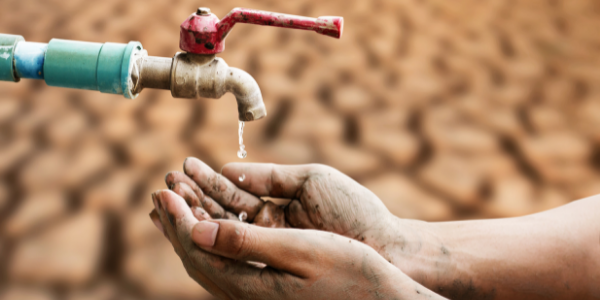Are We Running Out of Water?

By: Adam Stephenson | Jun 02, 2021
The World Wildlife Fund (WWF) reports some 1.1 billion people worldwide lack access to water, and a total of 2.7 billion people find water scarce at least one month of the year. Why are we running out of water? There is an abundance of water, however, the problem is having access to a supply of potable water, or water that is fit for consumption. Even in countries with adequate water resources, water scarcity is still not uncommon. Water shortages can be caused by collapsed infrastructure, failed distribution systems, pollution, poor management, or other economical factors.
The U.S. Bureau of Reclamation recently forecasted historically low water supplies from the Colorado River in the coming months. According to the forecast, Lake Powell and Lake Mead, man-made lakes along the Colorado River that store water supplying millions of people and vast tracts of farmland, could shrink to historic lows this year. This forecast has triggered the federal government’s first-ever official shortage declaration (capitalpress.com). This is not an isolated issue, it is global.
Combating Water Scarcity
Water conservation is a complex issue, as we all share water resources. A holistic effort between governmental agencies, landowners, environmentalists, and conservationists has to take place. Holistic management applies a practical, common-sense approach to overseeing natural resources that takes into account economic, cultural, and ecological goals. We have highlighted some of these efforts below:
Education
Changing the face of water conservation involves education to motivate new behaviors. A UN report reveals that 72% of all water withdrawals are used by agriculture, 16% by municipalities for households and services, and 12% by industries. Coping with the coming era of water scarcity will require major overhaul of all forms of consumption, from individual use to the supply chains of major corporations. The public and private sectors should educate people on water conservation tips and water scarcity. It is also wise to promote alternative uses of water and wastewater in industry.
Recycling Wastewater
Now is the time to look at alternative uses for wastewater. Advanced technology is available that treats wastewater for other uses, including drinking. Good examples of holistic management are found in communities that operate sewage treatment plants while pursuing partnerships with clean energy producers to use wastewater to fertilize algae and other biofuel crops. The crops, in turn, soak up nutrients and purify wastewater, significantly reducing pumping and treatment costs. Since 70% of the world’s freshwater is used for agriculture, improving irrigation and recycling wastewater can help close the gap between supply and demand. In some cases, this means utilizing new technology and new ideas. In other cases, this means improving what is already in place, such as repairing or reutilizing existing infrastructure.
Distribution Infrastructure
Poor water infrastructure is devastating to public and environmental health. It wastes resources, both natural and financial. Old, outdated systems are problematic with increased breakages and extensive maintenance. However, much of this infrastructure is so expensive to replace that a smaller community or organization may not be able to finance a replacement project. This problem is not confined to developing countries. Pipes burst on a regular basis here in the U.S. prompting boil alerts, and sanitary sewage collection systems regularly malfunction and overflow.
Summary
This article only scratches the surface of the problem and discusses some potential solutions. Some other major concerns include pollution, population control, and global warming. Improvement in any of these areas is a step in the right direction that we can all benefit from.

